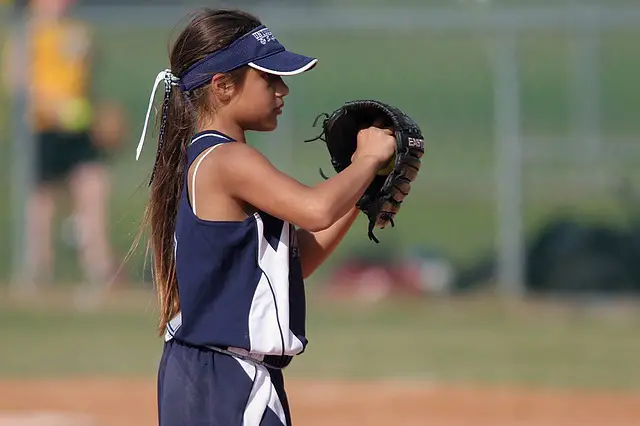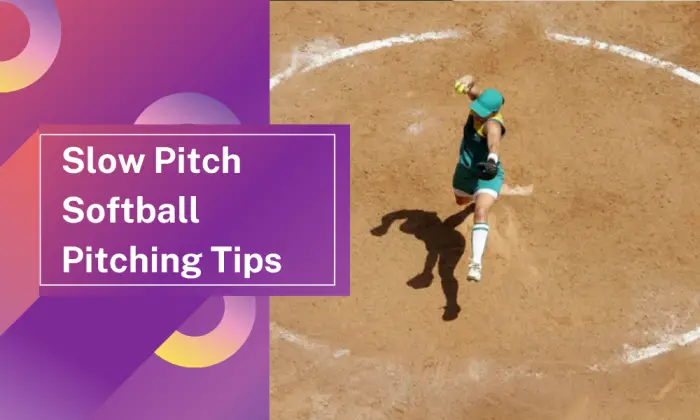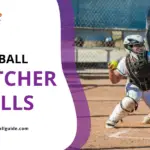Isn’t it difficult to pitch slowly and also master slow pitch techniques?
However easier it seems for a softball pitcher to pitch the softball slowly, it’s still hard to manage the perfect technique and pitch to hit the target.
In order to master the skill of slow pitching, you first need to figure out what works for you with different kinds of batters.
This can only be understood by continuous practice using the right techniques, and this article, as you read further, will help you to know how to slow pitch a softball.

Different Pitches in Slow-Pitch Softball
The goal of a slow-pitch softball pitcher is to get the hitter to hit in your defense and not to strike them out. This is achieved by delivering them with a pitch to control or just throwing some junk on the pitch where they can hit and prevent any direct contact.
The slow pitch pitching is the highest scorer in the game, and you can quickly become a slow-pitch pitcher if you consistently throw strikes.
However, slow-pitch softball can be quite complex to understand, and you can quickly get distressed. But don’t be discouraged as with continuous practice and the right techniques, one can excel in the game.
There are four different types of slow-pitch softball pitching techniques that are listed below with a brief description to enhance your game and level up your performance.

Backspin Slider
The backspin slider is the best technique to score high in the game as it has the highest spin rate and also has a sharp break to it. The slider is the pitch that breaks from your pitching arm or your glove arm side. In this technique, as the ball leaves your hand, it should be rotating onto your glove hand side.
The rotational axis of your pitch should never be perpendicular to the flight or track of the ball as it won’t break properly and run through due to the same pressure on both sides of the ball.
However, if you tilt the axis slightly while releasing the ball, then the pressure on one side increases more than on the other side.
The pressure should always increase on the pitching arm side to drive the ball toward your glove arm side. Now, as you go to the technique of gripping the ball, you will understand the axis of rotation relative to the flight of the ball perfectly.
The grip of the slider needs you to hold the ball with your two fingers and thumb with the strip aligned vertically between the two fingers. The horse-shoe of the striped ball should be upside down. Then take your index and middle finger over the ball, holding it with the tip of your fingers on the seam. Spread these fingers wide out to improve the rate of the spin.
The thumb of your hand needs to be placed between the seam and the vertical strip of the ball. The ring finger of your hand goes on the side, and its only responsibility is to work as a support. This is the grip for a backspin slider slow-pitch softball.
The backspin slider is the best way to accentuate your spin rate to get better action on the ball in the game. You only need to practice this as often as possible, even when you are on the field.
Screwball
The Screwball pitch is the best companion for the backspin slider pitch in the slow pitching techniques. As we know, the backspin slider breaks to your glove side, and the screwball is responsible for breaking on your pitching side.
This makes this pitching technique quite easy as well as comfortable. You do not have to worry if you are left-handed or right-handed as it does not matter at all.
The screwball is pitched in two seams just like the slider, and the rotational axis moves towards your pitching arm’s side. It is a companion pitch so it offers you the opportunity to throw them both to gain a good command over the location. This can benefit from scoring high as you can interrupt the timing of the hitter.
If the hitter knows that you can throw both pitches, it can clearly confuse him. He would have to wait up to the time the ball reaches half the way to the top of the arch to determine if it’s a straight pitch, or an inside or outside pitch.
The grip of the screwball is the same as that of the backspin slider where you hold the ball with the pads of your middle and index finger on the seam on the backside of the ball with the strip in between lined vertically.
The horseshoe shape of the seam should be placed upside down, and your thumb should be placed in between the seam and vertical strip.
The two fingers should be kept as wide apart as possible to accentuate the spin rate while pitching. This is quite similar to the backspin slider, with the only difference being the breaks that occur toward the pitching side of the player.
Backspin Power Pitch
The backspin pitching technique is one of the most challenging and essential pitches in slow-pitch softball. It is known as a straight backspin pitch but is also sometimes used as a backspin power pitch.
This is called a power pitch because once you develop the skills, you will be able to throw it with a high backspin rate to give you a number of advantages in the game.
The high backspin rate allows your ball to drop steeply from the top of the arc to down the plate of the hitting zone. This delivers the pitcher with an advantage of an angle as the hitter would be unable to score with such a steep angle.
The second and most important advantage is that the high backspin deflects the ball off of the bat in a downward motion.
The grip of this backspin power pitch requires you to hold the ball with your index finger and place your middle finger on the seam with the pads of the finger on the backside of the ball wide apart.
The wideness of the two fingers helps you achieve the highest backspin rate that allows the ball to break through the track.
In this pitch, you need to keep both ends at the extreme. This pitch means that if you can pitch as high as six feet or six and a half feet with the instruction of an umpire, then try to keep it down there.
The only goal is to prevent yourself from staying in the middle as it may make an easy target to hit for the hitter. Keep on changing your limits both up and down.
You need to practice and drill this pitch repeatedly to get skilled and always try to keep them short to make them more effective.
Knuckleball
The grip of the knuckleball requires the four fingers of your hand leaving the thumb to hold the ball. The four fingers are placed right across the seam using the fingernails of your four fingers.
You don’t need to have long nails for this technique. A little bit of a nail will work quite fine. The thumb is placed over the backside of the ball over the seam.
A little space is left between the palm and the ball but not too much. This is the grip for the knuckleball slow pitching technique. However, you can adjust the grip according to your convenience and preferences you can also use three fingers instead of four.
The only goal of the knuckleball pitching technique is to not rotate the ball a lot and allow it to move straight across the track. The knuckleball is successful only by the airflow around the seams.
The knuckleball requires the maximum arm speed to move the ball or successfully throw the pitch. You just need to practice a lot by adjusting your fingers, height, and distances to excel in this technique.
The knuckleball requires a tremendous amount of practice and consistency, as it can take someone years to excel in this particular pitch. There are even times this wouldn’t work at all but can sometimes be amazingly useful. As a batter hits a knuckleball pitch, it induces quite short flies that need your fielders to be ready for.
The knuckleball pitch is quite effective on the power hitters as it dances all over the place, confusing the hitter completely. This is the only pitch that can bounce in all directions from left to the right and back again.
The only downside of this pitch is that if thrown incorrectly, you can get shelled. But with continuous practice, you can easily excel in this pitch.
You need to experiment with your grip by turning a little bit, making different angles, do not turn at all, adjust your arm speed by decreasing or increasing its pitching velocity. This will help you get the perfect pitch technique in a few practices. The only focus on a knuckleball pitch is to prevent the ball from rotating a lot.
How to Slow Pitch a Softball
There are many different techniques to slow pitch a softball. It is also the main reason to score in the game for your team. One of the primary methods to slow pitch a softball is described below. It will help you go through the process and understand the whole technique and requirements of being a slow-pitch softball pitcher.
Step 1: Holding the ball in the dominant hand
The ball is held on the palm of the pitcher’s dominant hand to have full contact between the ball and the fingers. The fingers are wrapped around the ball in a comfortable way for the pitcher and gripped tightly with the fingers and the thumb. You need to hold the ball as tightly as possible to avoid slipping of the ball.
Now, if you are a right-handed pitcher, hold the ball in your right hand. If you are a left-handed pitcher, then hold it in your left hand.
Step 2: Position the body to throw
Now stand in the direction of the hitter where you need to pitch the ball. Then you need to take a step back on your dominant side to keep you slightly angled to your target.
If you are uncomfortable with this position, you can easily adjust by keeping your feet together or bending your waist slightly.
However, you need to keep in mind to keep your knees soft and prevent them from locking up as they might disturb the pitch.
Step 3: Position the arm to throw
As you take a step back, bring your arm on the backside alongside your hip. Now hold the ball tightly in your hands on the back before you start to pitch. The ball is kept below the waistline of your body with your arm straight out. Always ensure that your palm is facing toward the target.
Step 4: Throwing with technique
Now take one step ahead with the foot that was placed behind you and swing your hand forward and backward. The ball is released from the palm as soon as the hand passes your thigh by loosening your fingers to allow the ball to slide off. The ball flies up following the arch and reaches the target.
The movement of the throw should be quick but not forceful as it may deliver you an excessive speed warning from the umpire.
Pitching Tips for Slow Pitch Softball
As one of the most crucial aspects of slow pitch softball, pitching requires a combination of accuracy, speed, and strategy.
Whether you’re a beginner or an experienced player, improving your pitching skills can significantly enhance your overall performance on the field.
- Focus on Your Release Point: When pitching, make sure you release the ball at the same point every time. This consistency will help you throw accurate pitches and make it harder for the batter to hit your pitches. You can practice your release point by setting up a target on a wall or using a pitching net.
- Use Different Pitches: Slow-pitch softball allows for a variety of pitches, including fastballs, change-ups, and breaking balls. By using a mix of pitches, you can keep the batter guessing and increase your chances of striking them out.
- Vary Your Speed: In addition to using different pitches, you should also vary your speed to keep the batter off-balance. Try throwing a slow pitch followed by a fast one to keep the batter guessing.
- Focus on Your Footwork: Your footwork is crucial when pitching. Make sure you have a solid foundation and a good stride towards the plate. This will help you generate more power and accuracy in your pitches.
- Practice, Practice, Practice: As with any skill, practice is essential for improving your pitching. Set aside time to practice your pitching skills regularly, and consider working with a coach or taking lessons to get feedback on your technique.
Slow Pitch Softball Grips
Here are some common slow pitch softball grips:
- Four-Seam Fastball Grip: This is a basic grip for a fastball pitch, where you hold the ball with all four fingers across the top of the ball and the thumb underneath. This grip allows for a straight, accurate pitch with some speed.
- Circle Change-Up Grip: To throw a change-up pitch, you can use a circle grip where you form a circle with your thumb and index finger and hold the ball with your other three fingers. This grip helps to slow down the ball and create a deceptive pitch that looks like a fastball but drops in speed as it approaches the plate.
- Knuckleball Grip: For a knuckleball pitch, you can grip the ball with your fingertips, keeping them close together and pressing them into the seams of the ball. This grip creates a fluttering effect on the ball as it moves through the air, making it difficult for the batter to predict the ball’s trajectory.
- Curveball Grip: To throw a curveball, you can use a grip where you place your middle and index fingers on top of the ball, along the seams, and your thumb underneath. This grip allows you to spin the ball as it leaves your hand, creating a curve that drops down and away from the batter.
- Riseball Grip: A riseball is a pitch that looks like it is going to drop but then rises as it approaches the plate. To throw a riseball, you can use a grip where you place your index and middle fingers on the top of the ball, slightly to the side, and your thumb on the bottom. This grip allows you to create backspin on the ball, which causes it to rise as it travels through the air.
These are just a few of the many grips you can use in slow pitch softball. Experiment with different grips and find the ones that work best for you and your pitching style.
Remember to always practice your grips and pitches regularly to improve your accuracy and control.
Injury Prevention and Maintenance
As with any sport, there is a risk of injury when playing slow-pitch softball, especially for pitchers who are constantly using their arms and shoulders.
Here are some tips for injury prevention and maintenance:
- Stretching and warming up before pitching is essential to prevent injuries. Make sure to stretch your arms, shoulders, back, and legs to increase flexibility and prevent muscle strains.
- Proper form and technique are also important in preventing injuries. Make sure to follow the correct pitching mechanics and avoid overuse of your arm.
- Rest is crucial for injury prevention and maintenance. Make sure to take regular breaks during games and practice to give your arm and shoulder time to recover.
- Strengthening exercises can help prevent injuries and improve your pitching performance. Focus on exercises that target your arms, shoulders, and back.
- If you experience any pain or discomfort while pitching, stop immediately and rest. Ignoring pain can lead to further injury and a longer recovery time.
- Regular visits to a physical therapist or sports medicine doctor can also help prevent injuries and ensure that you are maintaining good pitching health.
By following these injury prevention and maintenance tips, you can keep yourself in good pitching shape and avoid potential injuries that could sideline you for the season.
Remember to always listen to your body and take care of yourself both on and off the field.
Final words
Pitching is quite a hard position to play. But with a good slow pitch glove, continuous practice, and improved techniques, you can score games for your team.
You just need to keep on practicing your pitching drills and focus on making the ball keep hitting the target.
We hope that this article helps you understand the different slow-pitch softball techniques and helps you level up your skills and forms in the game.



